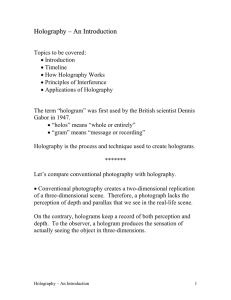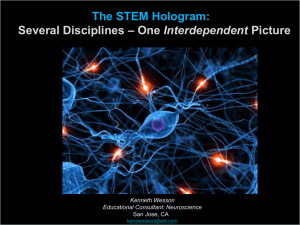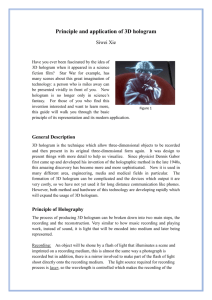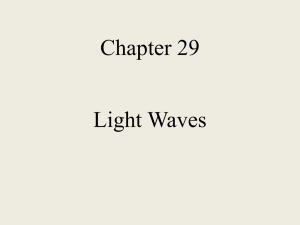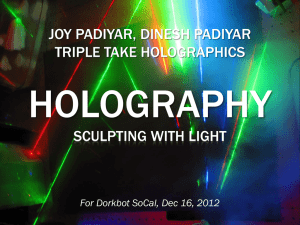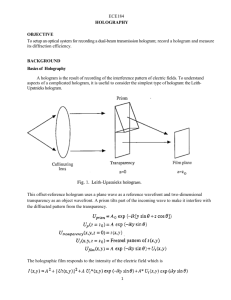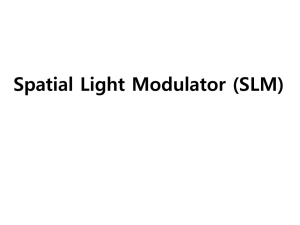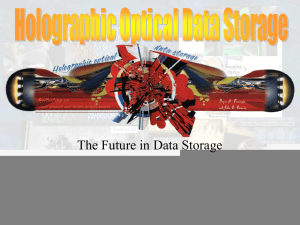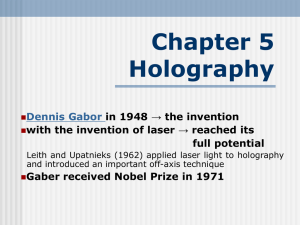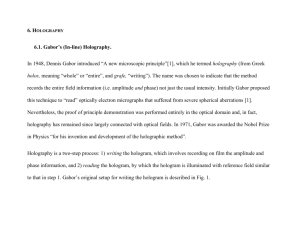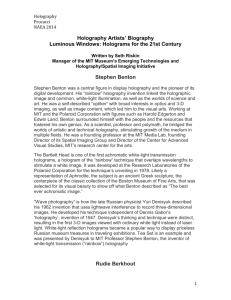3-2-holographic neural networks
advertisement
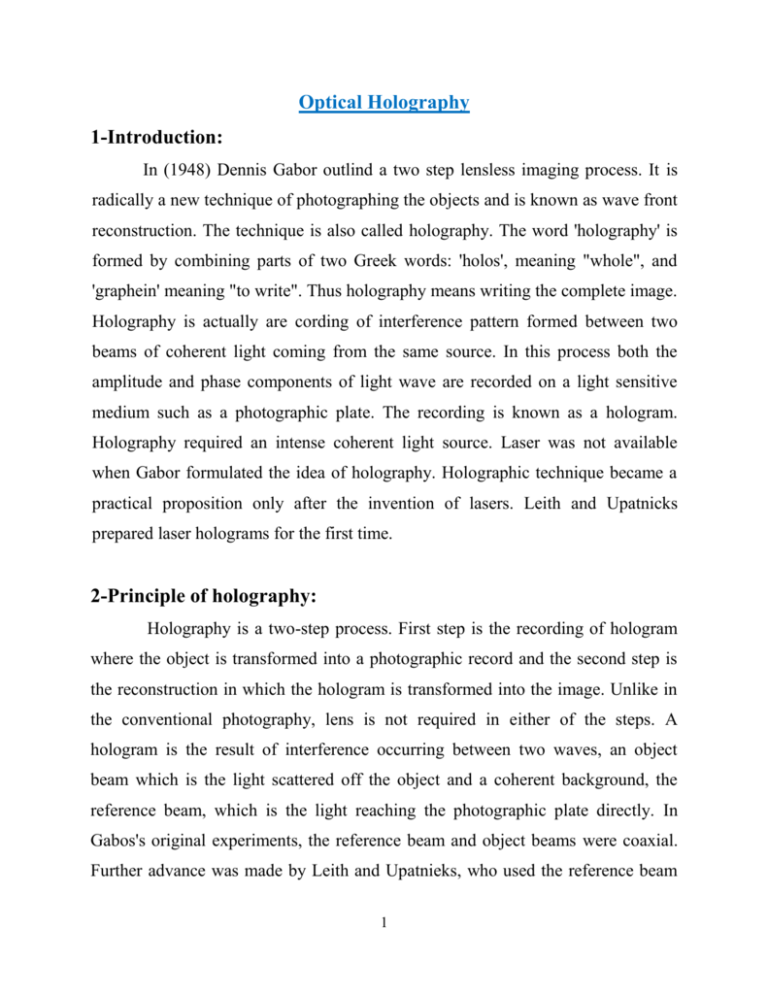
Optical Holography 1-Introduction: In (1948) Dennis Gabor outlind a two step lensless imaging process. It is radically a new technique of photographing the objects and is known as wave front reconstruction. The technique is also called holography. The word 'holography' is formed by combining parts of two Greek words: 'holos', meaning "whole", and 'graphein' meaning "to write". Thus holography means writing the complete image. Holography is actually are cording of interference pattern formed between two beams of coherent light coming from the same source. In this process both the amplitude and phase components of light wave are recorded on a light sensitive medium such as a photographic plate. The recording is known as a hologram. Holography required an intense coherent light source. Laser was not available when Gabor formulated the idea of holography. Holographic technique became a practical proposition only after the invention of lasers. Leith and Upatnicks prepared laser holograms for the first time. 2-Principle of holography: Holography is a two-step process. First step is the recording of hologram where the object is transformed into a photographic record and the second step is the reconstruction in which the hologram is transformed into the image. Unlike in the conventional photography, lens is not required in either of the steps. A hologram is the result of interference occurring between two waves, an object beam which is the light scattered off the object and a coherent background, the reference beam, which is the light reaching the photographic plate directly. In Gabos's original experiments, the reference beam and object beams were coaxial. Further advance was made by Leith and Upatnieks, who used the reference beam 1 at an offset angle. That made possible the recording of holograms of threedimensional objects. 2-1-Recording of the hologram: In the off-axis arrangement a broad laser beam is divided into two beams, namely a reference beam and object beam by a beam splitter. The reference beam goes directly to the photographic plate. The second beam of light is directed onto the object to be photographed. Each point of the object scatters the incident light and acts as the source of spherical waves. Part of the light, scattered by the object, travels towards the photographic plate. At the photographic plate the innumerable spherical waves from the object combine with the plane light wave from the reference beam. The sets of light waves are coherent because they are from the same laser. They interfere and from interference fringes on the plane of the photographic plate. These interference fringes are a series of zone-plate like rings, but these rings are also superimposed, making a complex pattern of lines and swirls. The developed negative of these interference fringe-patterns is a hologram. Thus, the hologram does not contain a distinct image of the object but carries a record of both the intensity and the relative phase of the light waves at each point. 2 Figure (1): Hologram recording: the interference pattern produced by the reference wave the object wave is recorded 2-2-Reconstruction of the image: Whenever required, the object can be viewed. For reconstruction of the image, the hologram is illuminated by a parallel beam of light from the laser. Most of the light passes straight through, but the complex of line fringes acts as an elaborate diffraction grating. Light is diffracted at a fairly wide angle. The diffracted rays from two images: a virtual image and a real image. The virtual image appears at the location formerly occupied by the object and is sometimes called as the true image. The real image is formed in front of the hologram. Since the light rays pass through the point where the real image is it can be photographed. The virtual image of the hologram is only for viewing. Observer can move to 3 different positions and look around the image to the same extent that he would be able to, were he looking directly at the real object. This type of hologram is known as a transmission hologram since the image is seen by looking through it. The original configuration adopted by Gabor for recording hologram was a coaxial arrangement, as illustrated in figure (2). In this arrangement the real image is located in front of the virtual image and is inconvenient for viewing or photographing. The advantage of the off-axis configuration is that the two images are separate. The fundamental difference between a hologram and an ordinary photograph is like this. In a photograph the information is stored in an orderly fashion: each point in the object relates to a conjugate point in the image. In a hologram there is no such relationship; light from every object point goes to the entire hologram. This has two main advantages 1-As the observer moves sideways viewing the hologram, the image is seen in three dimensions 2-If the hologram were shattered or cut into small pieces, each fragment would still reconstruct the whole object, not just part of the object. 4 Figure: (2) Image reconstruction: light diffracted by the hologram reconstructs the object wave. 3-Applications: 3-1-Holographic optical elements A hologram can be used to transform an optical wave front in the same manner as a lens. In addition, computer generated holograms can produce a wave front having any arbitrary shape. As a result, holographic optical elements (HOEs) can perform unique functions and have been used in several specialized applications. A major advantage of HOEs over conventional optical elements is that their function is independent of substrate geometry. In addition, since they can be produced on thin substrates, they are quite light, even for large apertures. Another advantage is that several holograms can be recorded in the same layer, so that 5 spatially overlapping elements are possible. Finally, HOEs provide the possibility of correcting system aberrations in a single element, so that separate corrector elements are not required. The recording material for a HOE must have high resolution, good stability, high diffraction efficiency and low scattering. Photoresists and dichromated gelatin are, at present, the most widely used materials. Photopolymers are an attractive alternative. 3-2-holographic neural networks: Holographic neural networks are attractive because they offer large storage capacity as well as parallel access and processing capabilities during both the learning and reading phases. In a holographic neural network, neurons are represented by the pixels on a spatial light modulator. The brightness of a pixel corresponds to the activation level of the neuron. If a pair of pixels are illuminated with a coherent beam, a volume hologram can be formed in a suitable recording material. If, subsequently, one of the original two beams is used to address the hologram, the other beam is reconstructed with an efficiency that represents the weight between these neurons. With a photorefractive recording material, a process of learning can be implemented by increasing, or decreasing, the weights selectively. 3-3-Acoustic holography It is easy to produce coherent sound waves. Sound waves readily propagate in solids. Therefore, a three dimensional acoustical hologram of an opaque object can be made. By viewing such hologram in visible light the internal structure of the object can be observed. Such techniques will be highly useful in the fields of 6 medicine and technology. In one of the techniques, two submerged coherent sound generators emit the reference and the signal, scattered by an object, respectively. On a calm surface of water, these two contributions produce ripples. The ripple pattern is the hologram. The pattern may be photographed and then reconstructed. As sound waves can propagate through dense liquids and solids, acoustical holography has an advantage in locating underwater submarines etc and internal body organs show in figure(3). Figure (3) 7
